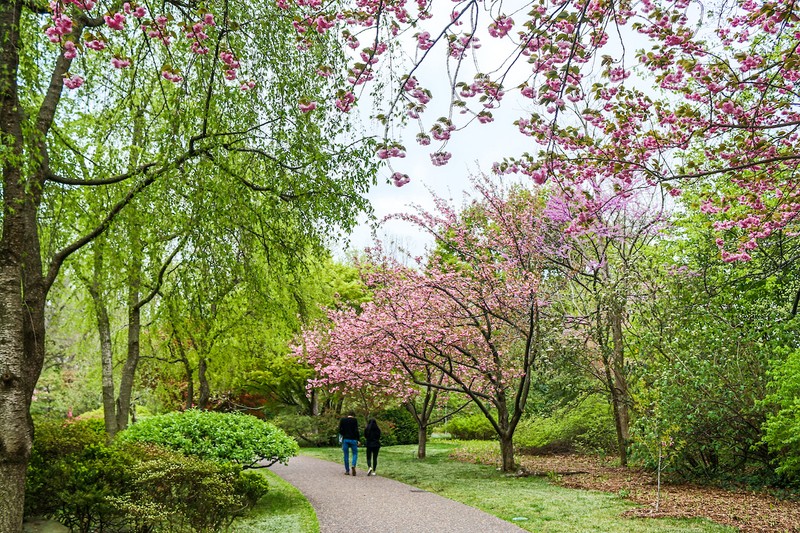Missouri Botanical Garden
Introduction
Text-to-speech Audio
Established in 1859 by Henry Shaw, the Missouri Botanical Garden provides the public with access to horticultural displays and plant information, while also advancing scientific knowledge through research. As a museum of plants, the Botanical Garden maintains indoor and outdoor ornamental horticultural displays featuring plants from around the globe. Indoor collections include plants such as orchids, ferns, bromeliads, acacias, yuccas, and cacti. Outdoor collections feature trees such as willow, pine, magnolia, and oak. There is an Italian garden, a rose garden, and perennial gardens with pathways and decorative water features. The Linnean House, built in 1882, is the oldest continuously operated public greenhouse west of the Mississippi River. Designed by George Barnett, it is also the only greenhouse that remains standing from the institution's early decades. Today, the Missouri Botanical Garden is one of the leading botanical gardens worldwide. It was nominated to the National Register of Historic Places and designated a National Historic Landmark in 1976. A major renovation is underway for the Visitors Center, which will update the facility for the 21st century.
Images
Missouri Botanical Garden, archival photo of the original glasshouse-style conservatory

Missouri Botanical Garden, architectural rendering of the new Visitors Center planned for future

Missouri Botanical Garden, archival photo of late 19th-century visitors strolling through the garden

Missouri Botanical Garden walkway in springtime, c. 2020s

Missouri Botanical Garden horticultural display, archival photo

Missouri Botanical Garden horticultural display, c. 2020s

Backstory and Context
Text-to-speech Audio
The Missouri Botanical Garden was founded in 1859 by the Englishman Henry Shaw. Upon arriving in St. Louis in 1819, Shaw became involved in various enterprises such as agriculture, mining, and and real estate. Through these pursuits, he amassed considerable wealth and was able to retire in 1840 at the age of thirty-nine. However, historians have noted that Shaw's financial circumstances were also made possible due to the labor of several enslaved persons from 1822 to 1860.
In 1851, Henry Shaw made a trip back to England to view the Great Exhibition of London, which included collections of plants from around the world. Afterwards, he decided to use his wealth to fund philanthropic endeavors in St. Louis, including the construction of a new botanical garden. To accomplish his goal, Shaw sought assistance from the Harvard botanist, Asa Gray, and also from Sir William Hooker, the director of the Royal Botanical Gardens at Kew near London. Shaw also asked the German-American botanist, Dr. George Englemann, to oversee the development of the plant collections.
Upon its opening in 1859, the Missouri Botanical Garden offered visitors the opportunity to stroll along outdoor walking paths and to view indoor horticultural displays of tropical plants in greenhouses, similar to what Shaw had observed in London. On site, there was also an herbarium (featuring a collection of botanical specimens) and a research library. From its earliest beginnings, the Missouri Botanical Garden's mission has remained "to discover and share knowledge about plants and their environment in order to preserve and enrich life." The institution continues to curate plant collections, maintain plant records, and advance scientific knowledge through research. Additionally, the Missouri Botanical Garden provides horticultural information to the public through exhibits, classes, and events. It is one of the top botanical gardens worldwide and one of the oldest botanical gardens in the U.S.
Sources
Missouri Botanical Garden: Visit , Missouri Botanical Garden . Accessed April 10th 2022. https://discover.missouribotanicalgarden.org/visit.
Our History, Missouri Botanical Garden. Accessed April 10th 2022. https://www.missouribotanicalgarden.org/about/additional-information/our-history.aspx.
Missouri Botanical Garden: National Historic Landmark, City of St. Louis, MO. Accessed April 10th 2022. https://www.stlouis-mo.gov/government/departments/planning/cultural-resources/Missouri-Botanical-Garden-National-Historic-Landmark.cfm.
Nomination Form, National Register of Historic Places. Accessed April 20th 2022. https://npgallery.nps.gov/GetAsset/baaa0b85-870e-4761-b926-687362d73790/.
Missouri Botanical Garden
Missouri Botanical Garden
Missouri Botanical Garden
